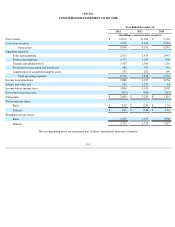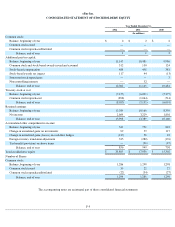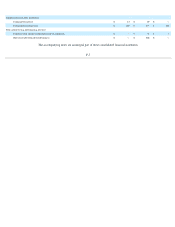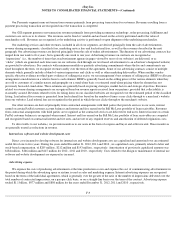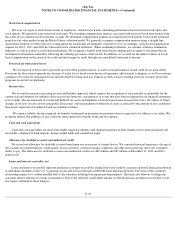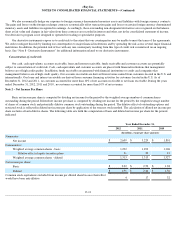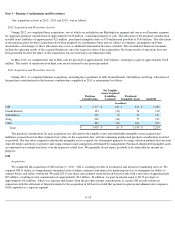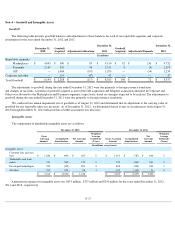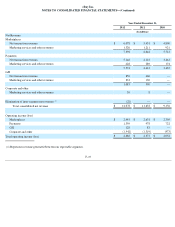eBay 2012 Annual Report Download - page 104
Download and view the complete annual report
Please find page 104 of the 2012 eBay annual report below. You can navigate through the pages in the report by either clicking on the pages listed below, or by using the keyword search tool below to find specific information within the annual report.
eBay Inc.
NOTES TO CONSOLIDATED FINANCIAL STATEMENTS—(Continued)
not significant for any period presented. Our cost method investments consist of investments in privately held companies and are recorded at
cost. Amounts received from our cost method investees were not material to any period presented.
We assess whether an other-than-temporary impairment loss on our investments has occurred due to declines in fair value or other market
conditions. With respect to our debt securities, this assessment takes into account the severity and duration of the decline in value, our intent to
sell the security, whether it is more likely than not that we will be required to sell the security before recovery of its amortized cost basis, and if
we do not expect to recover the entire amortized cost basis of the security (that is, a credit loss exists). We did not recognize an other-than-
temporary impairment loss on our investments in 2012 , 2011 , or 2010 .
Property and equipment
Property and equipment are stated at historical cost less accumulated depreciation. Depreciation is computed using the straight-
line method
over the estimated useful lives of the assets, generally, one to three years for computer equipment and software, up to thirty years for buildings
and building improvements, ten years for aviation equipment, the shorter of five years or the term of the lease for leasehold improvements and
three years for furniture, fixtures and vehicles.
Goodwill and intangible assets
Goodwill is tested for impairment at a minimum on an annual basis. Goodwill is tested for impairment at the reporting unit level by first
performing a qualitative assessment to determine whether it is more likely than not that the fair value of the reporting unit is less than its carrying
value. If the reporting unit does not pass the qualitative assessment, then the reporting unit's carrying value is compared to its fair value. The
fair values of the reporting units are estimated using market and discounted cash flow approaches. Goodwill is considered impaired if the
carrying value of the reporting unit exceeds its fair value. The discounted cash flow approach uses expected future operating results. Failure to
achieve these expected results may cause a future impairment of goodwill at the reporting unit. We conducted our annual impairment test of
goodwill as of August 31, 2012 and 2011. As a result of this test , we determined that no adjustment to the carrying value of goodwill for any
reporting units was required.
Intangible assets consist of purchased customer lists and user base, trademarks and trade names, developed technologies and other
intangible assets, including patents and contractual agreements. Intangible assets are amortized over the period of estimated benefit using the
straight-line method and estimated useful lives ranging from one to eight years. No significant residual value is estimated for intangible assets.
Impairment of long-lived assets
We evaluate long-lived assets (including intangible assets) for impairment whenever events or changes in circumstances indicate that the
carrying amount of a long-lived asset may not be recoverable. An asset is considered impaired if its carrying amount exceeds the undiscounted
future net cash flow the asset is expected to generate. In 2012 , 2011 and 2010 , no impairment was noted.
Foreign currency
Most of our foreign subsidiaries use the local currency of their respective countries as their functional currency. Assets and liabilities are
translated at exchange rates prevailing at the balance sheet dates. Revenues, costs and expenses are translated into U.S. dollars using daily
exchange rates if the transaction is recorded in our accounting systems on a daily basis, and otherwise using average exchange rates for the
period. Gains and losses resulting from the translation of our consolidated balance sheet are recorded as a component of accumulated other
comprehensive income.
Gains and losses from foreign currency transactions are recognized as interest and other, net.
Derivative instruments
We have significant international revenues as well as costs denominated in foreign currencies, subjecting us to foreign currency risk. We
purchase foreign currency exchange contracts that qualify as cash flow hedges, generally with maturities of 18 months or less, to reduce the
volatility of cash flows related primarily to forecasted revenue and intercompany transactions denominated in certain foreign currencies. All
outstanding derivatives are recognized on the balance sheet at fair value. The effective portion of the designated derivative's gain or loss is
initially reported as a component of accumulated other comprehensive income and is subsequently reclassified into the financial statement line
item in which the hedged item is recorded in the same period the forecasted transaction affects earnings.
F-12


